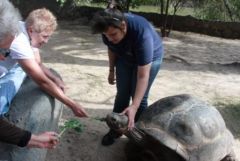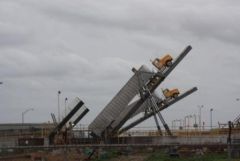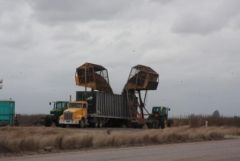-
Content Count
2713 -
Joined
-
Last visited
-
Days Won
44
Content Type
Profiles
Forums
Blogs
Gallery
Everything posted by tbutler
-
From the album: Winter Trips in the Rio Grande Valley
Louise is feeding kale to Houston, a Galapagos tortoise. We were cautioned not to let the stem of the kale get too short before we quit offering it to Houston. These tortoises we older than even the oldest members of our group!© @ Tom Butler
-
From the album: Winter Trips in the Rio Grande Valley
After a series of roars from the nearby lion the giraffes were excited and ran for quite a while. I would run too if I heard a lion roaring nearby.© @ Tom Butler
-
-
From the album: Winter Trips in the Rio Grande Valley
This baby giraffe is one of seven giraffes in the Gladys Porter Zoo in Brownsville, Texas.© @ Tom Butler
-
From the album: Winter Trips in the Rio Grande Valley
Loaded trucks are lifted on a hydraulic lift to empty them at the mill. From here sugar cane is shredded and the pulp is separated from the juice. The juice is purified and then sugar is crystallized out by adding powdered sugar to start the crystallization process. Finally, the raw sugar is separated from the molasses by a large centrifuge.© @ Tom Butler
-
From the album: Winter Trips in the Rio Grande Valley
Hopper Trailers carry the sugar cane from the harvesting machine to the tractor trailer truck for transport to the mill. Here two trailers are being dumped into a truck.© @ Tom Butler
-

Winter Adventures in South Texas
tbutler posted a blog entry in Tom and Louise on Tour in North America
Winter is just about over here in the southern tip of Texas. We've recently had a flurry of activity which keeps our minds off the cool weather, wind and rain we've had for the last two months. Last week Louise and I led three excursions for our park. Each of these was a delightfully different treat. On Wednesday we escorted a group from the park to the Cowley Sugar House in Santa Rosa, Texas. The distance is a moderate 40 miles and the trip was relatively easy with local roads most of the way. A security guard welcomed us to the Cowley Sugar House, which is the only sugar cane processing plant in Texas. We were directed to the office, where we were met by the safety officer, Ramiro Garces. He outlined the sugar growing, harvesting and processing that takes place in the area. For years we've seen the sugar fields burning but never knew exactly how or why this was done. It turns out that the field is burned to make the harvesting easier and more profitable. The harvesting machines don't have to work as hard and the harvest goes faster when the field is burned. It takes just 20 minutes to burn a field of 40 acres. After the fire, the sugar cane is left standing without all the leaves. The cane is cut and shredded by the harvester, transported to carriers and then transferred to tractor trailers for transportation to the mill. At the mill the fiber in the sugar cane is separated from the sugar. The fiber is dried and burned to produce all the electricity needed to run the mill. The sugar is concentrated into raw sugar and the molasses, a byproduct, is sold to the animal feed industry. The raw sugar is shipped to a refinery in Louisiana. Sugar cane is a perennial plant and is only replanted when the production of a field falls too low to be profitable. There are 119 sugar growers here in the Rio Grande Valley. They are all members of the cooperative that owns the Cowley Sugar House. It was very interesting to learn about an industry that we see all the time. Thursday, we took a group of 24 friends to the Gladys Porter Zoo in Brownsville. As zoos go, this one is small but it makes up for size with its displays which have some of the best viewing of any zoo we have visited. The animals were all active so we got to see plenty of action. We were escorted on a behind the scenes tour of the zoo by Emma Mitchell from the education department. We learned how the animals are fed and their cages cleaned. We were able to feed a pair of Galapagos tortoises and even pet one on the head. The whole group of tigers at the zoo are from discarded or confiscated pets. The island populated by spider monkeys is also a collection of former pets. It is good that the zoo is able to take some of these, but the discarded animals far exceed the capacity of the zoo. It is a sad commentary on human behavior. After a water break, we enjoyed seeing many of the smaller animals that are used by the education department and then the group dispersed to eat lunch and explore the entire zoo on our own. On Friday afternoon we traveled to Port Isabel to have dinner at the Port Isabel Yacht Club Hotel and Restaurant. We've visited the Yacht Club many times when we bicycle through Port Isabel. We've always said that we would love to eat dinner there some time so Louise took the lead and organized the trip. There were 16 people who made the 80 mile drive for dinner. Eight of us stayed the night at the Yacht Club to complete the adventure. Built in 1920, the Yacht Club has the look of a Bogie and Becall movie set. It hosted many distinguished guests, some notorious like Al Capone and others famous such as Lindbergh and Earhart. We arrived early and had cocktails in the parlor amid antique furniture and furnishings. The building is being restored by its present owner and has a long way to go but the restaurant serves up a fine meal and the staff is quite friendly. To say the rooms are rustic is to be generous. Still, if you enjoy the ambiance of an old resort with great character, this is a fine place to spend a night or two. Everyone enjoyed their experience. The trees in our park are breaking out in tiny green leaves and we'll have tons of flowers by the end of the month. Temperatures here in the Rio Grande Valley will be warming into the 80s on a regular basis soon and the winter will quickly be forgotten. One year we left the valley early to attend a convention in Philadelphia at the end of March. As we drove north we left the roadsides bursting with flowers behind. Driving north on the third day Louise turned to me and asked what had killed all the trees? I laughed and said, "They aren't dead, it is winter here." We both laughed. We had become so adjusted to the short southern winters that it was now a surprise to see all the leafless trees in March. The good news, my friends, is that the trees will be turning green further north soon. A wave of green will make its way all the way to the Arctic Circle and beyond. Daylight is getting longer each day and spring is on the way. It is time to start planning your summer travels and getting the motor home ready for the trip! -
GVWR is the Gross Vehicle Weight Rating. When the motor home weighs this much, you will be at full capacity. One more pound and you are overweight! This limit is related to the tires, brakes, suspension system, chassis design, etc. Exceed this weight limit and something will be damaged and eventually break. It then becomes a very serious safety concern. You now need to know the Unloaded Vehicle Weight which includes full fuel, oil and coolant but does not include fresh water, propane or waste tank fluids. Once you have this figure you can add up the weights for the propane (6 lbs per gallon), water (7 pounds per gallon - works for waste tanks also) and then subtract the difference between the unloaded vehicle weight plus the above additions from the GVWR. This is the weight of the driver, passengers, clothes, computers, cameras, golf clubs, food, dishes, tools, lawn chairs, BBQ, etc. you will be able to carry. The GCWR is the Gross Combined Weight Rating. It is the combined weight of the motorhome and any towed vehicle or trailer. The answer to the 2005 Canyon question lies in the difference between the GVWR and the GCWR. Given your figures above, the Canyon (fully loaded as you travel with it and fueled) can weigh only 4000 pounds. Check the owners documentation for the Suncruiser for information about the hitch rating. The hitch must be rated for 4000 pounds also. As I indicated, the missing figure you have to find is the Unloaded Vehicle Weight. Our motor home has a sheet which gives all these weights. It is on the back side of one of the lavatory cabinet doors. I don't know where you will find it on your motor home but it should be there as I think all manufacturers were listing these values on a posting somewhere in the motor home for at least the last ten years. Read the sheet carefully and do a little math and you'll have your answers.
-
Thanks for the information. It is good to know that the La-z boy recliners come ready to anchor.
-

Toll hikes approved for Bay Area bridges
tbutler replied to tmoning's topic in Laws and Legislative Action
We all know that the infrastructure in this country is on its last legs. Bridges in particular have been neglected and many are in dangerously substandard condition. Larger, heavier vehicles bear the responsibility for the damage they inflict on these bridges. The bridge that collapsed in Minneapolis the year before the FMCA Convention in Minneapolis-St. Paul is just one example. Imagine how we would have felt if a caravan of motor homes on the way to FMCA had been crossing that bridge when it collapsed! Several years ago I crossed the Tappanzee bridge over the Hudson at New York City. The toll was well into the teens I believe. I thought that was a huge toll but then I saw a program detailing the condition of that bridge and I'm glad they are collecting tolls to help replace it. The tolls raise such a small amount that they can't possibly pay the bill on their own. I can imagine that the $160,000 mentioned above is just a tiny part of what is needed to bring these bridges up to standard. I know for a fact that the Oakland Bay Bridge is in terrible shape and is being used only because they have put some emergency band aids in place to keep it "safe." One of those band aids failed last year and shut the bridge down for several days until it could be patched up yet again. The prosperity of this country is threatened by the deteriorating condition of our infrastructure. We must rebuild the country from the ground up and it is going to cost us, now or later. I'm in favor of paying now. The cost will only go up as we postpone this important work. Given the recent events in Haiti and the nature and history of the San Francisco Bay area, I think these bridges should be considered a national emergency and improving their condition should be a top priority. -
What a nice inviting looking interior that makes. Should be some great conversations there! Good work. Did you anchor the recliner to the floor?
-
Thom and Ouarda, Here is another vote for taking a toad (towed car) on your journey. It will take a little time and some money to get it outfitted but you will have a much easier time if you plan to take the coach to a campground and park it for the time you plan to be in an area. It then becomes your stationary house while you take the car to all the places in the area you would like to explore. Lots of people do transport a motorcycle or scooter and they make hitch carriers for either of these. I rode motorcycles for many years but I wanted an all-weather vehicle available. One way to think about a toad is to consider it a life raft. If you have a breakdown along the road somewhere you can unhook the toad and go for help if you can't get it by phone. As you get into traveling you will develop a comfort level with going to more remote places. If you are concerned about the toad impeding this, you can always unhook and drive the two vehicles separately when the going gets more difficult. I'm betting that 99% of your travel you will never even notice the toad behind you. When you get to the last 1% of miles on a trip, unhook and drive separately if needed. Where have we been with our motor home? Death Valley, Big Bend National Park, John Day Fossil Beds, the Lewis and Clark Trail, Yosemite, Alaska, Canada (almost all) and more. We've been on ferries to several islands, we've picked up a few scratches from trees that were a little too friendly and gotten into places where we had to back out to get out! It is all worth it. You will meet some wonderful people who like you have decided to escape the normal day to day life that most other people have to live. Full timers, we are the fortunate few!
-

Using Class A Motorhome in Cold Weather
tbutler replied to thomwells's topic in Systems and Appliances
Thom and Ouarda, welcome to the full time lifestyle, enjoy the journey. Once you go full time, you can use the propane heat on a regular basis as you'll be out moving around and can pick up propane on the road as you move from one place to another. We use electric space heaters to warm a room that is a little cool but never leave them on or even plugged in when we leave the coach. Propane heating is our normal heat. We'll occasionally use electric heat pumps if the propane is running low and the temperatures aren't too cold. Our propane heater has heat vents in the floor and the ductwork then also warm the compartments below. If you are in doubt about how effective this is in your coach, put a thermometer in the compartments with water and waste tanks. The roof heat pumps are great for medium cool weather but when it gets really cold, the propane heat is much more efficient. In most coaches the electric heat units are the heat pumps which double as air conditioners. Some roof units are air conditioners which have electric heating elements rather than being heat pumps. You should be able to check your owners manual for information about your units. If you can't find the information in your owners manual, check the roof unit manufacturers web site. Look up the model in your coach and it will be described there. If your unit has heat strips instead of being a heat pump its efficiency won't be affected by the outside temperature though its output may not be sufficient to keep up with the heating demands of cold weather. If I were you, I'd wait until late May or early June to head for Minnesota. The weather there really is warm at the right time. Watch the weather trends and travel accordingly. We've spent lots of time in Canada and found it quite comfortable through late spring, summer and early fall - most of the time! -

Albuquerque Convention
tbutler replied to southerner15's topic in FMCA Albuquerque, New Mexico, 2010
I can answer part of your question. The admission for the convention includes most seminars and entertainment. There are just a few seminars that have a fee, usually very small and they usually require advance registration. Check the program for the convention on line to find those that have fees. The entertainment is included! There is usually coffee and donuts in the morning, also free, and then look for the vendor sponsored events where you can get ice cream, various give away items, etc. Regarding parking, the FMCA parking is assigned spaces which is yours during the convention. If you are parking at an alternate location with another group, you may not have assigned spaces. Check with your group leader for information about your parking arrangements. At FMCA they will park you as you arrive and that spot becomes yours for the convention. Enjoy the convention. -
If you have found the carpet immediately after it has become wet, use a wet vac, towels or other absorbent materials, heat and ventilation or a dehumidifier depending on the ambient weather to dry out the carpet. I prefer ventilation unless you have to do this during very cold weather. You can move much more water quickly with ventilation, particularly if the outside air is low humidity. Even if the outside air is cold, even cold and damp, warming it will dry it out and make it very effective at removing excess water using ventilation. Open the windows and vents and let the air flow through the coach to remove the moisture. After you have dried the carpet as best you can, have a carpet cleaner come in and clean the carpet. Let them know that the carpet was wet and they should be able to treat it to take care of any potential mold problem. They will also give you instructions for drying the carpet after they finish. Follow their instructions carefully and you should be fine. If the carpet has been wet for some time before you discovered the problem, you likely have a mold problem already and should have the carpet replaced once you are certain you have identified the leak and had it fixed.
-
There are several suppliers of ladder mount brackets. You can examine and purchase them at any FMCA Convention. You will also find them advertised in Family Motor Coaching Magazine. That takes care of the rear of the vehicle. There are two methods for the front of the coach, neither works for us. One solution is a set of brackets that mount the plate above the front license plate using the license plate mounting bolts. The front of our coach curves outward above the license plate mount and the plate would rub on our paint. The other solution is a set of brackets on suction cups for use inside the windshield. I would only advise this when parked. I wouldn't want the plate falling down while you are driving. We have a sun screen on our front windshield which obscures everything inside the coach. So we do not have our membership number displayed on the front of the coach except when parked at conventions. I have rigged a way to hang it from the windshield wiper with a bungee cord and that keeps the parking committee happy! I did see one coach that had the membership oval painted or decal on the front of the coach but I never talked to the people to find out where they had this done. Perhaps it was their own handiwork. It was on the front above the left side of the windshield and it looked great. I'd have it done if I could find the person who did it.
-
Welcome to the FMCA and the Forum Steve and Nancy, No doubt you will learn much here but I suspect you also have much to offer. With full timing over a 20 year period, you have a sense of the history of living full time in an RV that few of us have. I know in our 8+ years we have seen changes in how we do things on the road. Part of it is learning and part of it is advances in technology. Please jump right in and share your insights with the rest of us.
-
Welcome Patricia, We are members of several groups that are not location based and attend their rallies when we are near where the rally is being held. We belong to Monaco International for the association with our manufacturer and its benefits with things like maintenance and tech support at rallies. As you attend a number of these rallies you make friends within the group. We also belong to the Full Timers Chapter. There are numerous other chapters that may interest you that are not linked to any specific area.
-
We are towing with a tow bar having purchased a vehicle which will allow this without modification other than the attachment baseplate for the tow bar and braking installation. We went with a Roadmaster Sterling Tow Bar and the Brakemaster braking system. We have been very happy with this arrangement since purchasing it. The Roadmaster people are at conventions and do inspections and maintenance at the conventions as well. After six years towing, I had to replace the tow bar due mostly to my insistence on backing up just a little bit once in a while when we got into a tight spot. You really can't back up without risking damage to the tow bar. When we started we towed with a dolly. That lasted just over a year. The dolly didn't hold up well, it had surge brakes and the device was not strong enough to handle the job. After two repairs of the braking system (no I didn't back up even a tiny bit with the dolly), we finally convinced the factory to replace the dolly. I took the replacement tow dolly and sold it without using it. If you get a dolly, purchase the highest quality dolly you can find. Check with tire dealers to find out if they routinely stock tires for the dolly. The one we had came with a tire size that we couldn't find anywhere and I checked in several large markets and spent time going through supplier books with several tire shops. It wasn't just a matter of finding the tires in stock, no one had a supplier that had that size trailer tire. I can't imagine going back to a dolly. If I didn't use the tow bar, I would go with an enclosed trailer for a small car. As my signature indicates, we have been on the road full time for almost nine years now. We had a 38' Dynasty before the current 40' Windsor. During that time we've towed almost 150,000 miles. The first 15,000 were with a dolly towing a Pontiac front wheel drive car, the last 135,000 were with a Chevrolet Trailblazer which requires shifting the transfer case to neutral and pulling two fuses after which it can be towed at highway speeds indefinitely. We've traveled all over the US and Canada with the Trailblazer in tow.
-
Byron, Don't feel like you are the Lone Ranger! I have a Garmin unit (etrex Vista HCX) that I got in 2008. I purchased the City Navigator Maps for this unit at the time of purchase. I wanted to get an update for the City Navigator Maps only to find out they have discontinued those maps. Now they are selling City Navigator NT so I will have to purchase a new map program in order to get an upgrade to current maps. Not only that, if I want to be able to further upgrade the maps I'll have to purchase a Lifetime Map Update contract or I won't be able to upgrade again. I think part of what is going on is the normal shake out of programs and systems that occurs as new technology is developing. Still, I think these companies are not being responsible to their customers. This clearly is not good customer support. I'm not sure that anyone will find any GPS system that isn't subject to the same adjustments and upgrade problems until the technology matures. Garmin has been threatening the same with the GPS Pilot that I have. It is an older unit, purchased about 1994. They are indicating that it will no longer be able to update the maps at all on that unit meaning I would have to purchase a new GPS unit to get current maps which are a must in aviation. This all goes along with the modern attitude about electronics and consumer goods in general. When is the last time you took a cell phone in to have it repaired? It costs almost as much to have a printer for your computer repaired as it does to purchase a new, faster, better printer. I don't have any idea where you would take a TV to get it repaired, I think you would have to ship it to a repair shop, the old mom and pop repair shops are pretty much gone. Millions of old analog TV sets will likely never be repaired because of the newer LCD digital TV's. The trend is to consider items as disposable rather than repairable. The technology changes so quickly that you are expected to purchase the newer much better item rather than have the old item repaired. I love the new technology but the resulting waste is disturbing.
-

Diesel Pusher Class A vs. Ford 460 Class C
tbutler replied to marshall2u@yahoo.com's topic in Buying an RV
Hello Marshall2u, Your second paragraph starts with the statement that you have your wife sold on RV'ing. At that point I would suggest that you should take the above advice about renting an RV and spending some time traveling with one. Try several weekends to different destinations or take a week or two vacation trip to a place that interests you. Once you have had a chance to experience traveling and living in an RV for a while, you will be in a better position to make a decision based on things like floor plans, different kinds of chassis/engines, options you like/need and other things that should be considered when purchasing a motor home. Renting an RV is not cheap but I consider it a good investment in learning what you like and don't like about different RV's. Think of it as RV buyers school. If you have never owned or driven one, you should try before buying. Don't be in a rush to buy. This is a buyers market. With the economy the way it is, you have the power, the seller is at your mercy. You have time to consider your options and try out several motor homes. If you do decide to purchase an RV, purchasing a used model is definitely the best decision for a first time RV'er! -
Before we went to Alaska in 2006, we stopped by Coastline Cover Company in the Los Angeles area. They outfitted us with a bra for both our Windsor and Trailblazer. They made templates of both as they hadn't previously done either of these vehicles. We have used the bra for the toad ever since. We also have the Roadmaster Guardian shield in addition to our full width mud flap as well as individual mud flaps on each wheel position. Being a toad is not an easy life! I will say that one of the problems we have with a bra, both the toad and the motor home bra, is that they do chafe the paint. Given our constant life on the road, this is a problem. I still use the bra on the toad as I think the chafing of the paint is less serious than the paint and windshield chips that come from rocks.
-
I use my economy mode all the time - unless I forget to select it. I was told once that the economy mode was planned to be the default mode but that too many people wanted the better performance. The person who said this claimed that people who were used to driving gasoline engines wanted to hear the higher RPM's they were familiar with instead of the low rumble of an efficient diesel engine. Your results are consistent with what I have found with our rig.
-
Wayne, Looking forward to meeting you sometime soon as well. Tom
-
Larry, Thanks again. I've saved your information for later reference. Thanks for posting the repairs you are making to your coach. I'll try to do the same in return.







